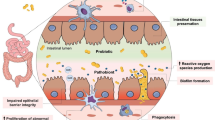Abstract
Germ-free mice, tested more than two weeks after removing their cecum, were at least 104 times more resistant than controls to intestinal colonization byClostridium botulinum type A or B. Histologic examinations were done with the cecum and colon taken fromC. botulinum-monoassociated mice. Specimens from mice with severe botulism had normal appearance. In specimens from chronically monoassociated mice, the pathogen was in the lumen, but not attached to the intestine. Scanning electron microscopy suggested a possible association of the pathogen with the mucous gel lining.
Similar content being viewed by others
Literature Cited
Arnon SS (1980) Infant botulism. Annu Rev Med 31:542–560
Burr DH, Sugiyama H, Jarvis G (1982) Susceptibility to enteric botulinum colonization of antibiotic-treated adult mice. Infect Immun 36:103–106
Burr DH, Sugiyama H (1983) Metronidazole-induced susceptibility of adult mice to intestinalClostridium botulinum colonization. Curr Microbiol 9:275–278
Churukian CJ, Schenk EA (1982) A method for demonstrating gram-positive and gram-negative bacteria. J Histotechnol 5:127–128
Helstrom PB, Balish E (1979) Effect of oral tetracycline, the microbial flora, and the athymic state on gastrointestinal colonization and infection of BALB/c mice withCandida albicans. Infect Immun 23:764–774
Lyons DE, Beery JT, Lyons SA, Taylor SL (1983) Cadaverine and aminoguanidine potentiate the uptake of histamine in vitro in perfused intestinal segments of rats. Toxicol Appl Pharmacol 70:445–458
McLeod WM, Trotter, DM, Lumb JW (1964) Avian anatomy, Minneapolis: Burgess
Miyazaki S, Sakaguchi G (1978) Experimental botulism in chickens: the cecum as the site of production and absorption of botulinum toxin. Jpn J Med Sci Biol 31:1–15
Moberg LJ, Sugiyama H (1979) Microbial ecological basis of infant botulism as studied with germfree mice. Infect Immun 25:653–657
Preece A (1972) A manual for histologic technicians. Boston: Little, Brown and Company
Rozee KR, Cooper D, Lam KK, Costerton JW (1982) Microbial flora of the mouse ileum mucous layer and epithelial surface. Appl Environ Microbiol 43:1451–1463
Savage DC, Dubos R, Schaedler RW (1968) The gastrointestinal epithelium and its autochthonous bacterial flora. J Exp Med 127:67–76
Sugiyama H, Mills DC (1978) Intraintestinal toxin in infant mice challenged intragastrically withClostridium botulinum spores. Infect Immun 21:59–63
Wang Y, Sugiyama H (1984) Botulism in metronidazoletreated conventional adult mice challenged orogastrically with spores ofClostridium botulinum type A or B. Infect Immun 46:715–719
Wells CL, Sugiyama H, Bland SE (1982) Resistance of mice with limited intestinal flora to enteric colonization byClostridium botulinum. J Infect Dis 146:791–796
Author information
Authors and Affiliations
Rights and permissions
About this article
Cite this article
Burr, D.H., Beery, J.T. & Sugiyama, H. Importance of cecum inClostridium botulinum colonization of mice and relationship of organism to large bowel. Current Microbiology 12, 277–281 (1985). https://doi.org/10.1007/BF01567978
Issue Date:
DOI: https://doi.org/10.1007/BF01567978




